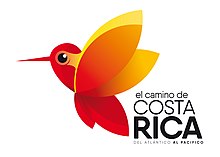Camino de Costa Rica
The Camino de Costa Rica is a 280 km long hiking trail across Costa Rica. It runs from the Atlantic Ocean (Caribbean coast), the southern most part of the Tortuguero Canals, up the mountain and through indigenous territory near the Barbilla National Park and through valleys and mountain ranges of the central region of the country, just south of the Turrialba and Irazu Volcanos and through the Los Santos coffee region down to the Pacific coast in Quepos.

History
By 2018, the rural population had declined from 40% inhabitants (2000) to 27% inhabitants, poverty at 25% was significantly higher than among the urban population, and income was more than 40% lower[1]. These sobering facts as well as other factors such as level of education, unemployment and underemployment in rural areas gave rise to the NGO, the Asociación Mar a Mar in year 2016. The aim of the Camino de Costa Rica is to establish a world class long distance trail and through its success in bringing hikers from all over the world, to improve the economic situation in the rural areas of Costa Rica.

65% of foreign tourists in Costa Rica are interested in ecotourism[2], which focuses on the elements of sustainable tourism - with the aim of promoting the exchange of services, the creation of jobs, the fight against poverty and socio-economic growth and at the same time reduce the social, cultural and environmental negative effects of tourism.[3]
Contribution
By the end of 2018, income from tourism in the region (6 municipalities) had already increased by 30%. New supply services and accommodation were founded in 12 municipalities, and new services (visits to plantations, archaeological visits, nature observation ...) were created. The number of hiking expedition operators had also increased.
Route
_-_03.jpg)

The route[4] can be started in the town of Barra de Parismina[5] or in the municipality of Barra del Pacuare, with the actual hike starting after a boat trip to view the Atlantic Ocean to the start point at the waypoint Goshen. The path continues through the territories Nairi Awari, the valley of La Angostura, a rural road by the side of the Tapanti National Park , the Orosi Valley and up to the highest point at 2,300 meters at El Empalme then trhough the coffee fields of Tarrazu and Los Santos area of Costa Rica and finally down to its end in the city of Quepos on the Pacific coast. The northern volcanoes Turrialba and Irazú can be seen from afar over long stretches of the way.


The path that runs through indigenous areas must be accompanied by indigenous hiking guides. Even if the rest of the way can basically be done on your own, until a good hiker’s manual is developed ( expected in 2021), it is recommended to be accompanied by a hiking guide. This serves not only for the visitor’s own security and information, but also for the mission to support the local population.
Links
- Camino de Costa Rica (official website)
- Conceptos basicos para la gestion de destinos turisticos
- Camino de Costa Rica (World Trails Network)
- Camino de Costa Rica (Kusini Collection)
- Letters from the trail hiking the Camino de Costa Rica (Tico Times)
- Camino de Costa Rica (Ballena Tales Magazine)
References
- "Costa Rica - Encuesta Nacional de Hogares 2018, Julio, 2018". Retrieved 27 June 2020.
- "Anuario Estadístico de Turismo 2018". Retrieved 27 June 2020.
- "EU Guidebook on Sustanable Tourism for Developement". Retrieved 27 June 2020.
- "Trail route".
- "Parismina, Limón".